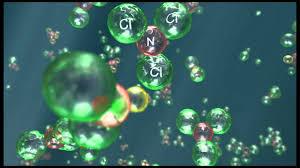Chloramines are secondary disinfectants that are added to the water supplies of some municipalities to provide longer disinfection in the distribution piping than chlorine. This process is important to avoid re-growth of bacteria in the pipes after clean water leaves the water treatment plant. Another advantage of chloramines over chlorine is that they tend to produce less disinfection byproducts like Trihalomethanes (THMs), which have been associated with cancer.
However, chloramines may cause undesirable taste and odor in water. In fact, the “chlorine smell” associated with swimming pools is actually the smell of chloramines that are typically used for pool disinfection. Chloramine treated water may also have a slightly green hazy color, which is not aesthetically pleasing.
These characteristics are undesirable in hospitality and foodservice applications where the taste and odor of water and beverages are critical.
In addition to undesirable taste and odor, chloramines can impact the lifespan of kitchen equipment and appliances. Chloramines can cause stainless steel surfaces to pit or rust over time. Rubber hoses, gaskets and o-rings may deteriorate faster in chloramine-treated water. This impact can translate into increased operational and maintenance costs for foodservice and office coffee water vendors.
It is possible to use chloramine-resistant plumbing such as synthetic polymer, flexible copper or corrugated stainless flex tubing. However, existing plumbing, (especially in old buildings) and other kitchen appliances may not be resistant to chloramines. Owners of older buildings should be aware that chloraminated water increases the rate of lead leaching from water.
Hospitality and foodservice vendors who maintain fish aquariums should also be aware that chloramine is toxic to fish. Chloramines enter directly into the blood stream of fish and cause hemoglobin to deteriorate.
It should be noted however, that drinking or cooking with water disinfected with chloramines in accordance with the applicable drinking water regulations is safe.
While chloramines are considered better residual disinfectants than chlorine, they are harder to remove from water. Boiling does not remove chloramines. Standard activated carbon filters are not effective in removing chloramines either because of the high contact time required for adequate removal.
A common non-chemical treatment technology for chloramine removal is specialized bituminous coal-based activated carbon filters that are designed to provide longer contact time than standard carbon filters. Filters that use fine mesh sizes of activated carbon increase the total surface area and therefore the contact time, thereby achieving higher removal efficiencies.
Here is a link to our NSF certified chloramines reduction systems.
Here is some additional foodservice reading on chloramines:





